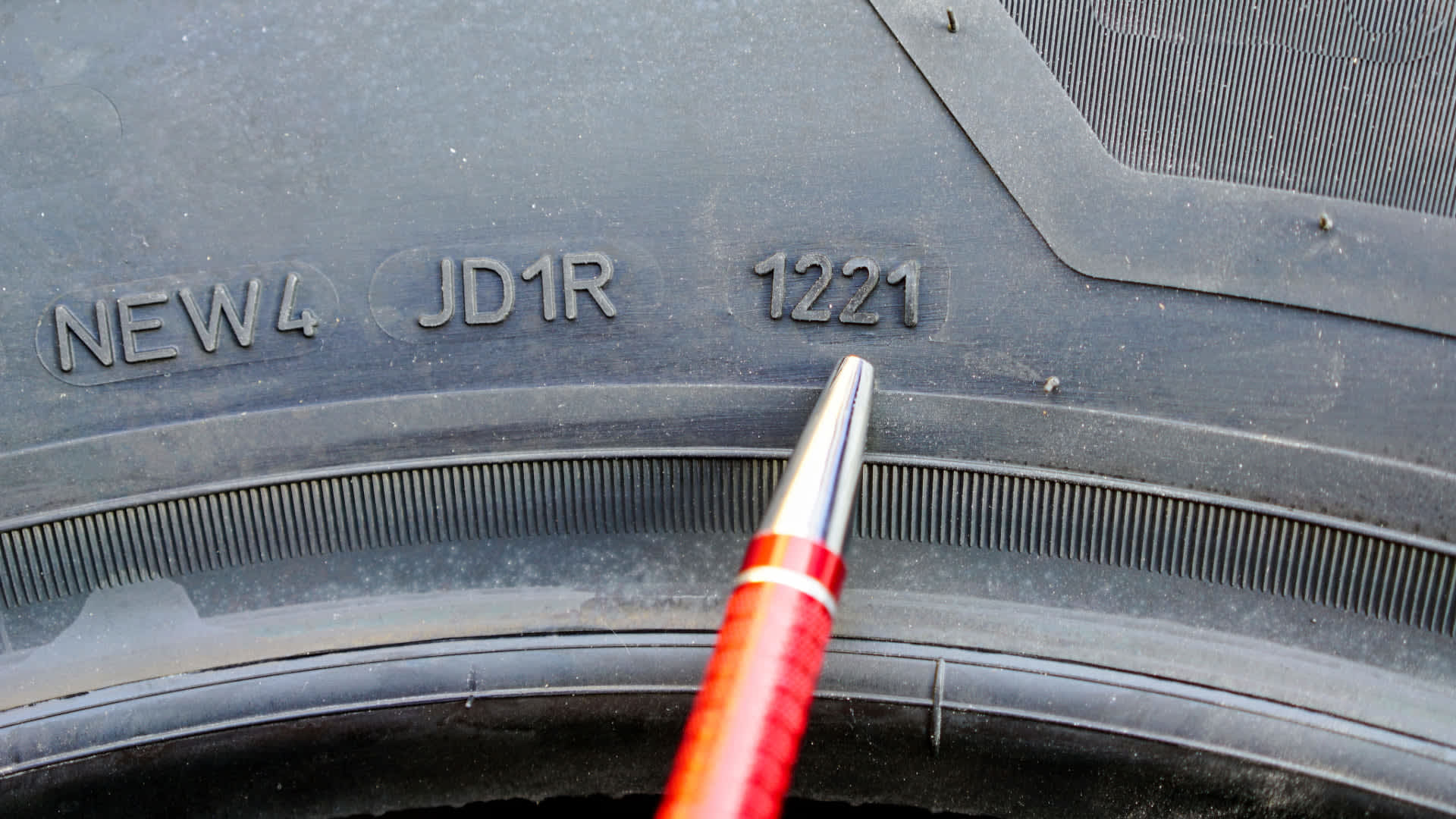Tire Buying Guides
Tire Age: How to Check Your Tire's Date Code

Best price guarantee
Tire replacement coverage
24/7 roadside assistance
Easy returns
Tire Buying Guides


The tire date code might seem like a small detail, but it's a big deal when it comes to your safety. Found on the sidewall as part of the Tire Identification Number (TIN), this code tells you exactly when your tire was manufactured—down to the week and year.
Why does this matter? Because tires aren’t built to last forever. Over time, rubber breaks down, even if your tread still looks fine. Driving on old tires can lead to poor traction, longer braking distances, and even blowouts—risks no one wants to take.
In this quick guide, we’ll show you how to find and read your tire’s date code to stay ahead of aging tires. It’s a simple step that helps you stay safe, confident, and in control on the road.
The tire date code might look like a random string of numbers, but it holds key details about your tire's age and safety. Found on the sidewall as part of the DOT (Department of Transportation) number, the last four digits reveal when the tire was made—specifically, the week and year of manufacture.
This simple code is more than just a number; it’s your window into how old your tires are. And that matters—because even if they look fine, tires naturally degrade over time. As the rubber ages, it becomes less effective at gripping the road and more prone to cracks or blowouts.
Understanding your tire’s date code empowers you to make smart, safety-first choices about when to replace them. After all, your tires are your vehicle’s only contact with the road—keeping them fresh and road-ready is one of the easiest ways to protect yourself and your passengers.
To check your tire’s date code, start by inspecting the tire’s sidewall—this is where key information about your tire lives, including the DOT marking. “DOT” stands for the Department of Transportation, and it's followed by a series of numbers and letters that identify where and when the tire was manufactured.
You may need to rotate the tire to spot the full DOT code, as it’s often printed on just one side. The last four digits of this sequence are what you're looking for—they tell you the week and year the tire was made. For example, a tire marked “2318” was manufactured in the 23rd week of 2018. This detail helps you gauge how much life your tire likely has left, especially since most tires should be replaced around the six-year mark, regardless of tread.
If your tire has only a three-digit code, it was made before 2000. The first two numbers indicate the week of manufacture, and the last digit points to the year within the decade—though these older tires can be tricky to interpret and may already be past their safe use window.
Regularly checking your tire’s age is a simple but effective way to stay on top of your vehicle’s safety. Knowing how to read the tire date code empowers you to replace aging tires before they become a risk.

Marked on the tire’s sidewall, the DOT number holds key information every driver should know. Think of the sidewall as your tire’s ID tag—it lists everything from size and load rating to the manufacturing details hidden within the DOT code. This code is especially important for determining the tire’s age and is often found on the inner sidewall.
When reading the DOT code, focus on the final four digits. These tell you the exact week and year the tire was made—for example, "1522" means it was manufactured in the 15th week of 2022. Be sure to use good lighting when checking the sidewall, as the numbers can be faint or dusty, and you may need to slightly rotate the tire if the DOT code is mounted facing inward. Taking just a few minutes to locate and read this code can help you stay on top of tire safety and performance.
Understanding how to read a tire’s date code is a simple but powerful way to stay safe. For tires made after 2000, the DOT code includes a four-digit segment that tells you the week and year the tire was manufactured. It’s a small detail that carries much weight—especially when deciding when it’s time for a replacement.
Here’s how it works: the first two digits indicate the week of the year, from 01 to 52, and the last two digits show the year. So if your tire’s code reads “2219,” it was made in the 22nd week of 2019. This info gives you a clear picture of the tire’s age, which is critical since tires naturally break down over time—even if they still look fine on the outside.
Knowing how to interpret the date code lets you stay ahead of issues that come with aging rubber, like reduced grip or risk of blowouts. It’s a quick check that can save you from bigger problems down the road and ensures your vehicle stays safe and road-ready.
Once you’ve found the DOT code on your tire, the last four digits are the key to unlocking its age. These numbers tell exactly when the tire was made—down to the specific week and year. For example, if the code ends in “2219,” the tire was manufactured in the 22nd week of 2019. This simple detail gives you an accurate timeline, helping you plan for maintenance or replacements.
Knowing your tire’s age isn’t just about being informed—it’s about staying safe. Tires naturally wear down and degrade over time, even if they don’t show visible damage. Heat, sun exposure, and regular use all take a toll. By understanding the date of manufacture, you can better gauge how much life your tires have left and avoid the risks of aging rubber. It’s a smart habit that adds peace of mind whenever you hit the road.
For tires made before 2000, figuring out their age takes a little extra detective work. Instead of a four-digit date code like modern tires, these older versions use a three-digit system. The first two numbers represent the week of production, while the last number indicates the year—without specifying the decade. So, a code like "229" means the tire was made in the 22nd week of a year ending in 9, such as 1989 or 1999.
Because these tires are decades old, it’s especially important to check their physical condition. Look closely for cracks, dry rot, or unusual wear, which can signal the rubber has aged beyond safe use. If you’re unsure, it’s always a good idea to consult a tire professional who can help assess whether the tire is still roadworthy. With older tires, safety comes first—when in doubt, it’s best to replace.

Knowing when to replace your tires is essential for staying safe and keeping your vehicle performing at its best. Most tires have a lifespan of about six to ten years from the date they were made, though that can vary depending on how you drive and how well your tires are stored and maintained. Regularly inspecting your tires helps you catch issues early and avoid unexpected problems down the road.
Key Signs It’s Time to Replace Your Tires:
Be aware of any changes in how your car handles. If you notice unusual vibrations, increased road noise, or a drop in fuel efficiency, your tires could be wearing unevenly or developing internal issues. Staying in tune with how your car drives and keeping an eye on your tires can help you make timely replacements and keep your journeys smooth and safe.
1. How do I find the tire date code?
To find your tire’s date code, take a close look at the tire's sidewall. You’re looking for a string of characters that begins with “DOT.” This code tells you important details about your tire, including when it was made. Sometimes the full code is on the inner side of the tire, so you may need to rotate it slightly to get a clear view.
2. What do the numbers in the date code mean?
The last four digits of the DOT code hold the key. The first two numbers show the week your tire was made (from 01 to 52), and the last two represent the year. For example, a code that ends in "2319" means the tire was manufactured in the 23rd week of 2019.
3. Why does my tire’s age matter?
Tires don’t last forever—even if they look okay. Over time, the rubber breaks down, and old tires can lose traction or become more prone to blowouts. Knowing how old your tires are helps you decide when to replace them, which keeps you safer on the road.
Search By